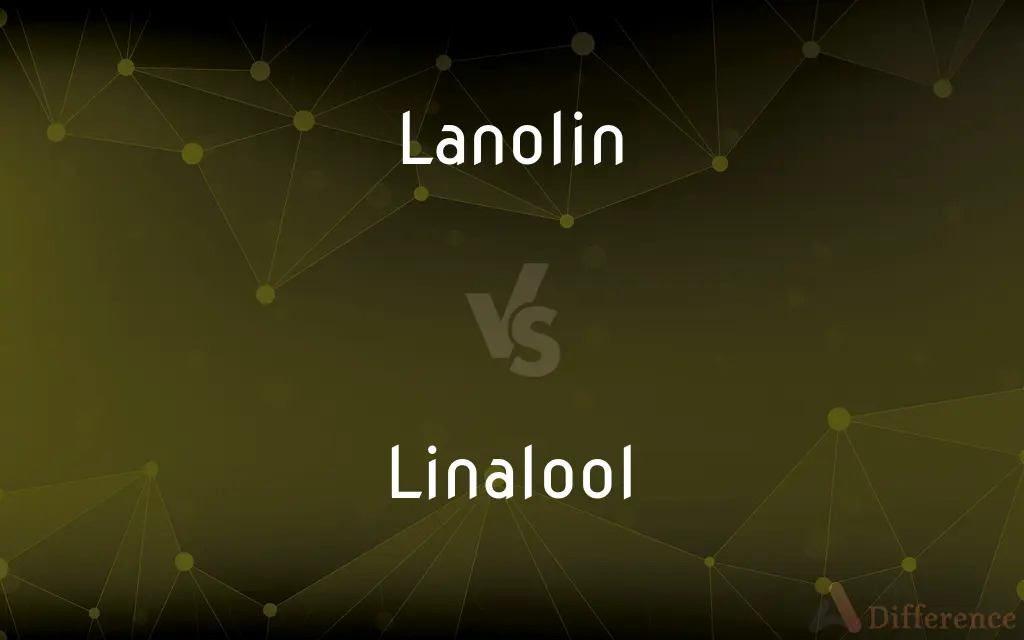Lanolin vs. Linalool — What's the Difference?
By Tayyaba Rehman & Maham Liaqat — Updated on March 12, 2024
Lanolin is a natural wax from sheep's wool, used as a moisturizer. Linalool is a fragrant alcohol found in many plants.

Difference Between Lanolin and Linalool
Table of Contents
ADVERTISEMENT
Key Differences
Lanolin, derived from sheep's wool, is primarily used in skincare and cosmetic products for its excellent moisturizing properties. It works by creating a barrier on the skin's surface, which helps to prevent moisture loss, making it particularly beneficial for dry and chapped skin. Whereas linalool, a naturally occurring terpene alcohol found in over 200 species of plants, is valued for its pleasant floral scent, commonly used as a fragrance ingredient in perfumes, cosmetics, and cleaning products. While lanolin serves a functional role in hydrating and protecting the skin, linalool is used to enhance the sensory experience of products through its aroma.
While lanolin is celebrated for its emollient properties, it can sometimes cause allergic reactions in sensitive individuals. On the other hand, linalool, despite its widespread use for its aromatic properties, is identified as a potential allergen by some regulatory bodies and can also cause allergic reactions in certain people when oxidized upon exposure to air. Both ingredients, therefore, require careful consideration by manufacturers and consumers, especially those with sensitive skin or allergies.
Lanolin's use is not limited to cosmetics; it also finds applications in pharmaceuticals and industrial products due to its lubricating properties and ability to protect against rust. Linalool, in contrast, besides perfumery and cosmetics, is utilized in the production of vitamin E and serves as a precursor in the synthesis of other aroma compounds. The versatility of both compounds extends beyond personal care, highlighting their importance in various industries.
The extraction and sourcing of lanolin and linalool also differ significantly. Lanolin is obtained through the processing of wool grease, a byproduct of sheep wool cleaning before it is spun into yarn. This makes lanolin animal-derived and not vegan. Linalool, however, is extracted from plant materials such as the flowers and spices that naturally contain it, classifying it as a vegan ingredient. These sourcing differences are crucial for consumers concerned with animal welfare and those seeking vegan products.
Despite their distinct primary functions, lanolin and linalool share a commonality in their application in the cosmetic industry. Lanolin is sought after for its ability to moisturize and repair the skin, while linalool's appeal lies in its capability to add a pleasant fragrance to products without the harshness of synthetic perfumes. Both ingredients contribute to the sensory attributes and efficacy of cosmetic formulations, albeit in different ways.
ADVERTISEMENT
Comparison Chart
Source
Sheep's wool
Over 200 species of plants
Primary Use
Moisturizer in skincare and cosmetics
Fragrance ingredient in various products
Allergic Reactions
Possible, especially in sensitive individuals
Can cause allergies, particularly when oxidized
Additional Uses
Pharmaceuticals, industrial applications
Production of vitamin E, synthesis of aroma compounds
Sourcing
Animal-derived (not vegan)
Plant-derived (vegan)
Role in Cosmetics
Hydrates and protects skin
Adds fragrance without synthetic harshness
Compare with Definitions
Lanolin
A moisturizing agent derived from sheep's wool.
Lanolin cream soothes my dry hands in winter.
Linalool
A naturally occurring compound in many plants.
The linalool in lavender oil gives it a calming fragrance.
Lanolin
Softens and smooths the skin.
The lanolin in the lotion made my skin feel silky smooth.
Linalool
Can cause reactions in sensitive individuals.
I check labels for linalool due to my fragrance allergies.
Lanolin
Utilized for its lubricating properties.
Lanolin is often used in industrial lubricants to prevent rust.
Linalool
Serves as a precursor in producing vitamin E.
Linalool is crucial in the biochemical production of vitamin E.
Lanolin
Not suitable for vegans.
I switched to a plant-based moisturizer because I avoid animal-derived products like lanolin.
Linalool
Used to enhance the scent of products.
Linalool adds a fresh, floral note to my favorite perfume.
Lanolin
Helps to prevent moisture loss in the skin.
Using lanolin-based lip balm keeps my lips hydrated all day.
Linalool
Derived from plant sources.
I prefer products with vegan ingredients like linalool for their natural fragrance.
Lanolin
Lanolin (from Latin lāna 'wool', and oleum 'oil'), also called wool yolk, wool wax, or wool grease, is a wax secreted by the sebaceous glands of wool-bearing animals. Lanolin used by humans comes from domestic sheep breeds that are raised specifically for their wool.
Linalool
Linalool () refers to two enantiomers of a naturally occurring terpene alcohol found in many flowers and spice plants. This pair has multiple commercial applications, the majority of which are based on its pleasant scent (floral, with a touch of spiciness).
Lanolin
A fatty substance obtained from wool and used in soaps, cosmetics, and ointments. Also called wool fat.
Linalool
A colorless, fragrant liquid, C10H18O, distilled from the oils of rosewood, bergamot, and other plants and trees and used in perfume manufacture.
Lanolin
A greasy yellow substance chemically akin to wax that is secreted from wooly animals, with a variety of uses from rust prevention, lubrication and waterproofing to cosmetics and skin ointments.
Linalool
(chemistry) A monoterpene alcohol found in many essential oils.
Lanolin
(transitive) To treat with lanolin.
Linalool
A colorless fragrant liquid found in many essential oils
Lanolin
A peculiar fatlike body, made up of cholesterin and certain fatty acids, found in feathers, hair, wool, and keratin tissues generally.
Lanolin
A yellow viscous animal oil extracted from wool; a mixture of fatty acids and esters; used in some ointments and cosmetics
Lanolin
An emollient containing wool fat (a fatty substance obtained from the wool of sheep)
Common Curiosities
Where does linalool come from?
It is extracted from over 200 species of plants, including lavender and coriander.
Can lanolin cause allergic reactions?
Yes, it can, particularly in individuals with sensitive skin.
Is linalool vegan?
Yes, being plant-derived, linalool is considered a vegan ingredient.
Can linalool be used in all types of cosmetics?
Yes, it is commonly used across a wide range of products for its fragrance, including lotions, perfumes, and soaps.
What is lanolin used for?
Primarily as a moisturizer in skincare and cosmetic products, thanks to its emollient properties.
How is lanolin extracted?
It is obtained from the grease in sheep's wool during the wool-cleaning process.
Are there alternatives to lanolin for vegans?
Yes, plant oils and butters, such as shea butter and coconut oil, are popular vegan alternatives.
How does lanolin benefit the skin?
It moisturizes, creates a protective barrier, and helps to repair dry, chapped skin.
Is linalool safe to use?
While generally safe, it can cause allergic reactions in some individuals, especially when oxidized.
Why is lanolin not considered vegan?
Because it is derived from sheep's wool, making it an animal byproduct.
What makes lanolin unique among moisturizers?
Its ability to mimic human skin oils, providing exceptional moisturizing and protective properties.
Can I use lanolin on my face?
Yes, but it's important to patch test first if you have sensitive skin or are prone to breakouts.
What products commonly contain linalool?
Perfumes, soaps, shampoos, and cleaning products, due to its pleasant floral scent.
Why might someone avoid lanolin?
Due to allergies, vegan lifestyle choices, or personal preference for plant-based products.
How does linalool affect a product's fragrance?
It adds a natural, floral aroma, often making synthetic fragrances unnecessary.
Share Your Discovery

Previous Comparison
Generalized vs. Specialized
Next Comparison
Creosote vs. CarbolineumAuthor Spotlight
Written by
Tayyaba RehmanTayyaba Rehman is a distinguished writer, currently serving as a primary contributor to askdifference.com. As a researcher in semantics and etymology, Tayyaba's passion for the complexity of languages and their distinctions has found a perfect home on the platform. Tayyaba delves into the intricacies of language, distinguishing between commonly confused words and phrases, thereby providing clarity for readers worldwide.
Co-written by
Maham Liaqat













































